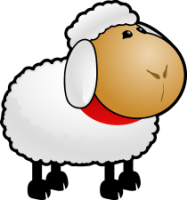Llamas
On our farm we have three Llamas. Their names are Charlie, Spot and Sandy. Spot is the son of Charlie and Sandy. Spot was born on our farm in August 2008. We had purchased Sandy and Charlie at a sales barn. These animals were very timid and it was hard to get close to them. Over the past two years we have been working with the llamas, trying to get them more used to people. Interaction with visitors to the farm has helped them overcome their natural fears of people.
Now they love to be hand fed treats while you feel their coats, the hair of which makes cashmere at a local spinning group. Charlie and Spot have gotten so comfortable that they greet you the gate and take carrots held in your mouth.
Charlie’s teeth are not set correctly so it makes it difficult for him to eat, but he seems to manage okay. It just takes him a bit longer to eat his grain. When Sandy was giving birth to Spot, she had a difficult time. Spot was very sick and needed immediate vet care to clear his lungs and to take antibiotics. He is a healthy llama now, growing quickly and loves to take swims in the pond. Spot enjoys children and will come close to give you a kiss.
Llamas Facts
The llama main job on the farm is protecting the other animals from predators. With the assistance of the donkey they were able to scare off a bear that entered the property. Their long sharp claws and hind legs can be used for defense.
Llama’s are from the cameo family and can drink a pail of water and preserve it for up to 3 days. It is important to always have fresh water available at all times.
Llamas are modified ruminants with a three-compartment stomach; they chew their cud. Because of relatively low protein requirement (about 12%), due to their efficient digestive system, they can live on a variety of pasture. They mainly eat hay, grain and grass. They like apples and carrots for treats. Carrots are their favorite. You could hold a carrot in your mouth and Sandy will take it from you. But you must stand still so she does not get scared.
Between the ages of two and three, males start developing curved and very sharp upper and lower fighting teeth, which can cause serious damage when fighting with other males or on an uncooperative female. These teeth are removed easily by your veterinarian using an obstetrical wire to saw them off just above the gum level.
Llamas naturally come from the South American Altiplano, which is high and dry. They do not handle heat and humidity as well. The need to be shorn in the spring and when it’s really hot we cool them by hosing their bellies or they will go for a swim in the pond.
Llamas like to hum. Humming can have many meanings: excitement, fear, frustration or, “Where’s breakfast?” Llamas also alarm call if there are strange things happening in their surroundings. They will also scream when fighting and the male’s orgle when breeding.
Spitting usually occurs amongst camelids in disputes over food or territory, seldom at people unless mistreated or undergoing a traumatic experience. A female may tell a male she is pregnant by spitting him off. All Llamas are known to spit when they feel threatened but these llamas are quite used to people now and usually don’t spit. Come enjoy watching these unique animals.
They are very curious creatures and love attention. so come by and visit Land O’ Lakes Petting Farm and say hi to Charlie, Spot and Sandy.
Like all our animals at Land O’Lakes Rescue Petting Farm – Our LLamas counts on visitors support or supporters like you to help with the cost of feed, vet bills, and of course bedding and hay.
If you would like to help click the subscribe button to setup a subscription payment, you can use credit card or automatic withdrawl from your bank each month. Every dollar helps us help them. Think about sponsoring our LLamas today.




Please Leave a Comment